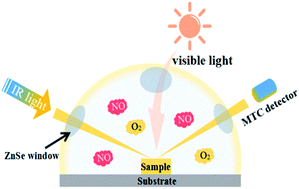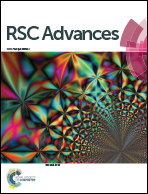In situ DRIFT investigation on the photocatalytic NO oxidation mechanism with thermally exfoliated porous g-C3N4 nanosheets
Abstract
Bulk g-C3N4 suffers from a low surface area and high charge recombination rate. To advance the photocatalytic efficiency of g-C3N4, porous g-C3N4 nanosheets were prepared using a simple thermal exfoliation method. The effects of thermal exfoliation time on the microstructure and photocatalytic performance of g-C3N4 was investigated. Porous g-C3N4 nanosheets treated for 4 h (C3N4-4h) exhibited a highly enhanced NO removal ratio of 51.2%, which is 3.2 times higher than that of bulk g-C3N4. The enhanced activity of C3N4-4h can be ascribed to an increased surface area and promoted charge separation. An in situ DRIFT investigation was applied to monitor the time-dependent NO adsorption–photocatalysis process. Based on the observed reaction intermediates, a molecular-level mechanism for photocatalytic NO oxidation with porous g-C3N4 nanosheets was proposed.



 Please wait while we load your content...
Please wait while we load your content...